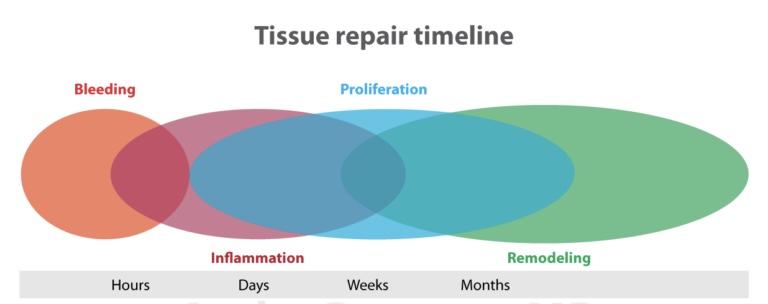Getting injured sucks! And the harder to we push our body, whether it’s to improve our fitness, or playing a sport that we enjoy, the more exposure we have to injuries. For most athletes and weekend warriors, the idea that nutrition can play an essential role in injury recovery makes sense. Yet, when injuries happen, very few of us know exactly how to use nutrition to improve healing. To fully recover from a minor strain or major surgery, you must meet certain nutritional needs to maximize your healing potential. To really understand how to use nutrition to help you maximize your healing potential, it is important to understand what is happening to the cells of your body during an injury.
3 Phases of Injury Recovery:
There are 3 phases of healing following an acute injury:
- Inflammation – fluid build-up around injured tissue
- Proliferation – rapid reproduction of new cells
- Remodeling – formation of new cells into new tissue
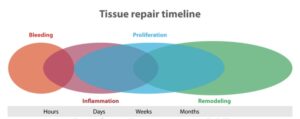
Inflammation is a normal response following acute soft tissue injuries. Acute inflammation results in increased permeability of the blood vessels, allowing more blood to arrive, and causes fluid build-up around injured tissue. This accumulation of fluid (edema) at the injury site should be considered a positive reaction as it increases sensitivity to pain and restricts movement (to prevent us from further injuring the tissue). Contained in this fluid build-up are healing white blood cells that begin the proliferation phase of healing at the injured site that will soon lead to remodeling of the injured tissue. The lymphatic system naturally and slowly removes all the waste products and excess fluid buildup caused by the inflammatory process. It turns out that we could be negatively affecting tissue remodeling and healing through our desire to get rid of inflammation with NSAIDS (Advil, Aleve, Motrin, Mobic, Naprosyn, naproxen, ibuprofen) and icing. For more on this please see NSAIDSs a Bad Choice For Your Injury? & Is the Use of Ice for Soft Tissue Injuries a Bad Idea?
Recovery from an injury is a complex process that involves:
- Managing inflammation
- Fueling the healing process
- Repairing damaged tissue
1. Managing Inflammation
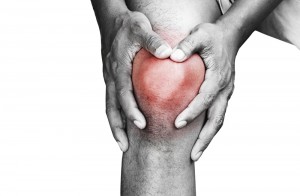 Swelling, pain, redness and heat are signs of inflammation that most of us readily identify following an injury. What you probably didn’t know is that inflammation isn’t a bad thing and is an important and necessary part of injury recovery. When an injury happens, some of the body’s cells in the injured area are damaged or destroyed. This triggers the body’s need to clear these damaged and destroyed cells and to start the process of new cell development. For as many as four days post-injury, it’s important not to attempt to decrease this inflammation phase because it can significantly increase recovery time. Following this initial 4-day stage, the focus should shift to managing inflammation.
Swelling, pain, redness and heat are signs of inflammation that most of us readily identify following an injury. What you probably didn’t know is that inflammation isn’t a bad thing and is an important and necessary part of injury recovery. When an injury happens, some of the body’s cells in the injured area are damaged or destroyed. This triggers the body’s need to clear these damaged and destroyed cells and to start the process of new cell development. For as many as four days post-injury, it’s important not to attempt to decrease this inflammation phase because it can significantly increase recovery time. Following this initial 4-day stage, the focus should shift to managing inflammation.
Managing inflammation can be a combination of diet and supplements. Some of the most important foods and supplements are omega-3 fats, bromelain and curcumin.
 A diet rich in omega-3 fats can help maintain the body’s normal inflammatory response to activity and injury. Research has shown that consuming 2-3 grams of omega-3s daily can positively influence markers of inflammation in the body. You can consume this amount through a diet containing two servings of fish per week combined with an increased intake of nuts, seeds, avocado, flaxseed & olive oil, chia and flax seeds—or through the addition of an omega-3 fatty acid supplement.
A diet rich in omega-3 fats can help maintain the body’s normal inflammatory response to activity and injury. Research has shown that consuming 2-3 grams of omega-3s daily can positively influence markers of inflammation in the body. You can consume this amount through a diet containing two servings of fish per week combined with an increased intake of nuts, seeds, avocado, flaxseed & olive oil, chia and flax seeds—or through the addition of an omega-3 fatty acid supplement.
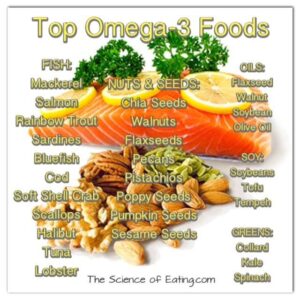
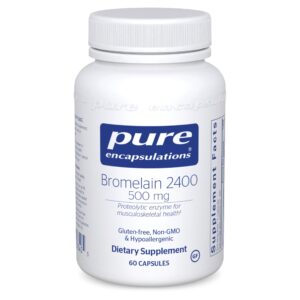 Bromelain, an enzyme found in pineapple, has been shown to help reduce swelling and bruising by helping to maintain a healthy inflammatory response to exercise and injury. Bromelain is recommended in amounts between 150-500 milligrams per day. Although all parts of the pineapple contain bromelain, it is most abundant in the stems, leading many people to add a bromelain supplement to their diet.
Bromelain, an enzyme found in pineapple, has been shown to help reduce swelling and bruising by helping to maintain a healthy inflammatory response to exercise and injury. Bromelain is recommended in amounts between 150-500 milligrams per day. Although all parts of the pineapple contain bromelain, it is most abundant in the stems, leading many people to add a bromelain supplement to their diet.
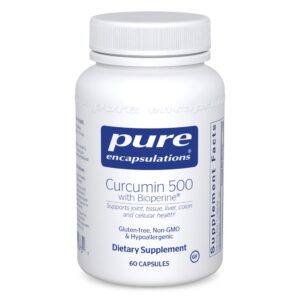 Curcumin, the active ingredient in the spice turmeric, has been used as a medicinal food for thousands of years. It is most commonly found in curry powder, but research has shown that supplementation of 500 milligrams twice daily can promote reduced swelling and tenderness, specifically in those with chronic inflammation.
Curcumin, the active ingredient in the spice turmeric, has been used as a medicinal food for thousands of years. It is most commonly found in curry powder, but research has shown that supplementation of 500 milligrams twice daily can promote reduced swelling and tenderness, specifically in those with chronic inflammation.
2. Fueling the Healing Process
Many people underestimate how many calories it takes to heal. Depending on the severity of the injury, calorie needs can increase by up to 20% above normal baseline. Often, this increased calorie need is offset by a decrease in energy expenditure due to the avoidance of strenuous exercise when injured.
Protein should be the focus of recovery, as it plays a major role in tissue regeneration and repair. Protein consists of amino acid building blocks. Many amino acids are crucial for recovery and cellular repair. One of these amino acids, glutamine, is considered essential in times of trauma or damage as an important source of energy in recovering cells. Another amino acid, leucine, has been shown to help slow muscle breakdown in injured individuals. The amino acid, arginine, can increase nitric oxide production, which can improve blood flow to damaged areas, providing important nutrients and promoting removal of dead and damaged cells. Amino acids are part of complete proteins in the diet, but some people prefer to take them directly in supplement form. An easy and appropriate target for healthy, active individuals is 1 gram of protein per pound of body  weight. Short-term minor injuries might not require additional protein, but longer-term injuries or major surgery can increase protein needs by up to 10%. Injured individuals can supplement their protein needs by adding a bone broth beef protein or a vegan pea protein to help support their diet.
weight. Short-term minor injuries might not require additional protein, but longer-term injuries or major surgery can increase protein needs by up to 10%. Injured individuals can supplement their protein needs by adding a bone broth beef protein or a vegan pea protein to help support their diet.
Repairing Damaged Tissue
The final piece of recovery nutrition involves supporting the creation of new tissue to replace the cells damaged by injury. While many vitamins and minerals are needed to support recovery, vitamin A, vitamin C and zinc get the most attention. Vitamins A and C help support the first few days of a beneficial inflammatory response and assist in the formation of collagen, which helps provide the structure of connective tissues such as tendons, ligaments and skin. Vitamin A has also been demonstrated to boost immune function, which is sometimes depressed after an  injury. Research has shown that a vitamin C deficiency can lead to irregular formation of collagen fibers, and hence to decreased stability of the tissues and abnormal scar formation. Zinc plays a role in new DNA creation, the ability of cells to multiply and protein synthesis. Zinc deficiency, which is fairly common, can inhibit wound healing. Recovering individuals might consider a multi-vitamin & mineral supplement containing vitamin A, vitamin C and zinc during the initial wound healing phase.
injury. Research has shown that a vitamin C deficiency can lead to irregular formation of collagen fibers, and hence to decreased stability of the tissues and abnormal scar formation. Zinc plays a role in new DNA creation, the ability of cells to multiply and protein synthesis. Zinc deficiency, which is fairly common, can inhibit wound healing. Recovering individuals might consider a multi-vitamin & mineral supplement containing vitamin A, vitamin C and zinc during the initial wound healing phase.
Most of us want to speed up the healing process, and you can with these easy tips to use nutrition to help you maximize your healing potential. It’s all about the right eating and supplement strategies to get you back in the game!
If you would like professional guidance in selecting the right nutrition approach and supplements for your condition, please contact us at Back to Function. One of our highly skilled doctors can evaluate your condition, render a diagnosis and guide you safely and effectively on the road to feel, recover and perform better. Please call 310-534-1900 or email info@backtofunction.com to schedule your assessment today!
References:
www.backtofunction.com. NSAIDS a Bad Choice For Your Injury?
www.backtofunction.com. Is the Use of Ice for Soft Tissue Injuries Actually a Bad Idea?
Calder PC. Omega-3 fatty acids and inflammatory processes. Nutrients. 2010 Mar;2(3):355-374.


